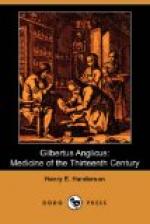Now to which of these Ricardi does the eulogistic language of Gilbert refer? Dr. Payne believes it to be the senior, Ricardus Salernitanus. Mr. Kingsford, on the other hand, thinks it to be Ricardus Parisiensis, who died in 1252. A Liber de urinis has been ascribed to each of them, but, it seems to me, with greater probability to Ricardus Salernitanus. If too the author of the “Anatomia Ricardi” was a contemporary of Gilbert, we might reasonably expect to find in the Compendium some evidences of Gilbert’s acquaintance with that work. But Gilbert’s discussion of anatomical questions is totally unlike that of the author of the “Anatomia,” and betrays not the slightest evidence of knowledge of such a treatise. On the whole then I am inclined to agree in this question with Dr. Payne, and to consider the Ricardus of Gilbert identical with Ricardus Salernitanus, the famous professor of the School of Salernum. This conclusion is further justified by the fact, generally accepted by all modern writers, that Gilbert was himself a pupil of Salernum.
Singularly enough, both Dr. Payne and Mr. Kingsford profess to find in the Compendium some evidence that Gilbert sojourned in Syria for a certain period, though the circumstances of this sojourn are viewed differently by the two biographers. Dr. Payne thinks that the physician, after completing his education in England, proceeded to the Continent and extended his travels as far as Syrian Tripoli, where he met Archbishop Walter and became attached to his staff. As the prelate returned to England in 1192, this sojourn of Gilbert in Syria must have been about 1190-91, when, according to Dr. Payne’s chronology, Gilbert could have been not more than about twenty years of age. Dr. Payne bases his story upon a certain passage in the Compendium, in which Gilbert says that he met in Syrian Tripoli “a canonicus suffering from rheumatic symptoms.” I have been entirely unable to find the passage referred to in this story, in spite of a careful search of the text of the edition of 1510. But, admitting the existence of the passage in question, it proves nothing as to the date of this alleged Syrian sojourn. Tripoli was captured by the Crusaders in 1109, and continued under their control until its recapture by the Saracens in 1289, a period of nearly two hundred years. Gilbert’s travels in Syria may then have occurred at almost any time during this long period, and his fortuitous meeting with Archbishop Walter has very much the appearance of a story evolved entirely from the consciousness of the biographer.




